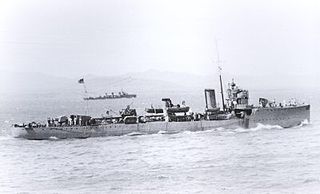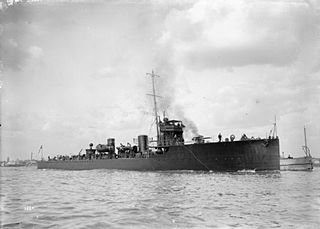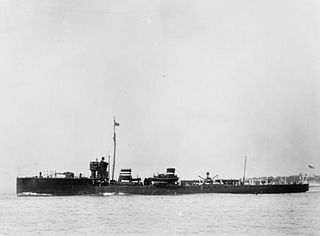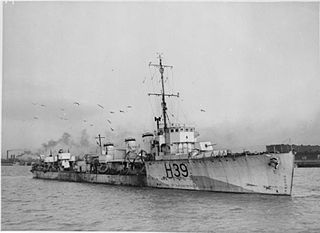
HMS Badger was an Acheron-class destroyer of the Royal Navy that served during the First World War and was sold for breaking in 1921. She was the eighth Royal Navy ship to be named Badger, after the mammal of the same name.

HMS Lizard was an Acheron-class destroyer of the British Royal Navy. She is named for the Lizard peninsula in the county of Cornwall in England. and was the twelfth ship of the Royal Navy to bear the name.

HMS Acheron was the name ship of the Acheron-class destroyer of the British Royal Navy. She is named after the River Acheron, believed in Greek Mythology to be a branch of the River Styx. She was the fifth ship of the Royal Navy to bear the name.

HMS Phoenix was an Acheron-class destroyer of the British Royal Navy. She is named for the mythical bird, and was the fifteenth ship of the Royal Navy to bear the name. She was the only British warship ever to be sunk by the Austro-Hungarian Navy.

HMS Ariel was an Acheron-class destroyer built in 1911, which served during the First World War and sank in 1918 after striking a mine. Named after Shakespeare's "airy spirit", or the biblical spirit of the same name, she was the tenth and last ship of the name to serve in the Royal Navy.

HMS Attack was an Acheron-class destroyer built in 1911, which served during the First World War and was sunk in 1917 in the Mediterranean by a German U-boat. She was the third ship of the name to serve in the Royal Navy.

HMS Beaver was an Acheron-class destroyer of the Royal Navy that served during the First World War and was sold for breaking in 1921. She was the ninth Royal Navy ship to be named Beaver, after the mammal of the same name.

HMS Goshawk was an Acheron-class destroyer of the Royal Navy that served during World War I and was sold for breaking in 1921. She was the sixth Royal Navy ship to be named after the bird of prey, Accipiter gentilis.

HMS Druid was one of 20 Acheron-class destroyers built for the Royal Navy during the 1910s. Completed in 1912 the ship served during World War I and was sold for scrap in 1921.

HMS Hind was an Acheron-class destroyer of the Royal Navy that served during World War I and was sold for breaking in 1921. She was the seventeenth Royal Navy ship to be named after the female deer.

HMS Forester was an Acheron-class destroyer of the Royal Navy that served during World War I and was sold for breaking in 1921. She was the ninth Royal Navy ship to be named after the traditional craft of forester.

HMS Lapwing was an Acheron-class destroyer of the Royal Navy that served during World War I and was sold for breaking in 1921. She was the seventh Royal Navy ship to be named after Vanellus vanellus, the northern lapwing.

HMS Sandfly was an Acheron-class destroyer of the Royal Navy that served during World War I and was sold for breaking in 1921. She was the seventh Royal Navy ship to be named after the small biting fly of the same name.

The first HMS Vehement was a V-class destroyer of the British Royal Navy that saw service in World War I. She spent her short career in minelaying operations in the North Sea before striking a mine and sinking in 1918.

HMS Abdiel was a Marksman-class flotilla leader of the Royal Navy, built by Cammell Laird during the First World War. She was converted to a minelayer during construction, commissioning during 1916, and served at the Battle of Jutland. Following the end of the war, Abdiel served in the Baltic during the Russian Civil War. She was sold for scrap in 1936.

HMS Tarpon was a Royal Navy R-class destroyer constructed and operational in the First World War. She is named after the large fish Tarpon; one species of which is native to the Atlantic, and the other to the Indo-Pacific Oceans. Tarpon was built by the shipbuilders John Brown & Company at their Clydebank shipyard and was launched in March 1917 and entered service in April that year.

HMS Telemachus was a R-class destroyer of the British Royal Navy that took part in the First World War. She was built in 1916–1917 by the Scottish shipbuilder John Brown at their Clydebank shipyard. Telemachus was modified to serve as a minelayer, laying minefields in the German Bight and English Channel to restrict the operation of German submarines. The ship survived the war and was sold for scrap in 1927.

HMS Princess Margaret was a minelayer operated by the British Royal Navy during and after the First World War. She was built by the Scottish shipbuilder William Denny for the Canadian Pacific Railway as a liner to serve on the Pacific West Coast, and as such was powered by geared steam turbines, giving a speed of 23 knots.
HMS Gabriel was a Marksman-class flotilla leader of the British Royal Navy, that took part in the First World War. The ship was built by Cammell Laird at Birkenhead, being launched on 23 December 1915 and entering service in July 1916. Gabriel served with the Grand Fleet, leading a destroyer flotilla and was later used as a minelayer. She survived the war, before being sold for scrap on in May 1921.

HMS Liberty was a Laforey-class destroyer that served with the Royal Navy during the First World War. Launched on 15 September 1913 as HMS Rosalind, the ship was renamed on 30 September under an Admiralty order to become one of the first alphabetical class destroyers. On commissioning, the vessel joined the Third Destroyer Flotilla and operated as part of the Harwich Force. During Battle of Heligoland Bight, Liberty engaged with the German torpedo boats G194 and G196, and scored two hits on the cruiser Mainz. On 8 February 1917, the destroyer rammed and sank the German submarine UC-46. The vessel also played a minor role in the battles of Dogger Bank, Dover Strait and Jutland, as well as acting as a convoy escort and patrolling the Dover Barrage. With the cessation of hostilities, the ship was placed in reserve and sold to be broken up on 5 November 1921.




















